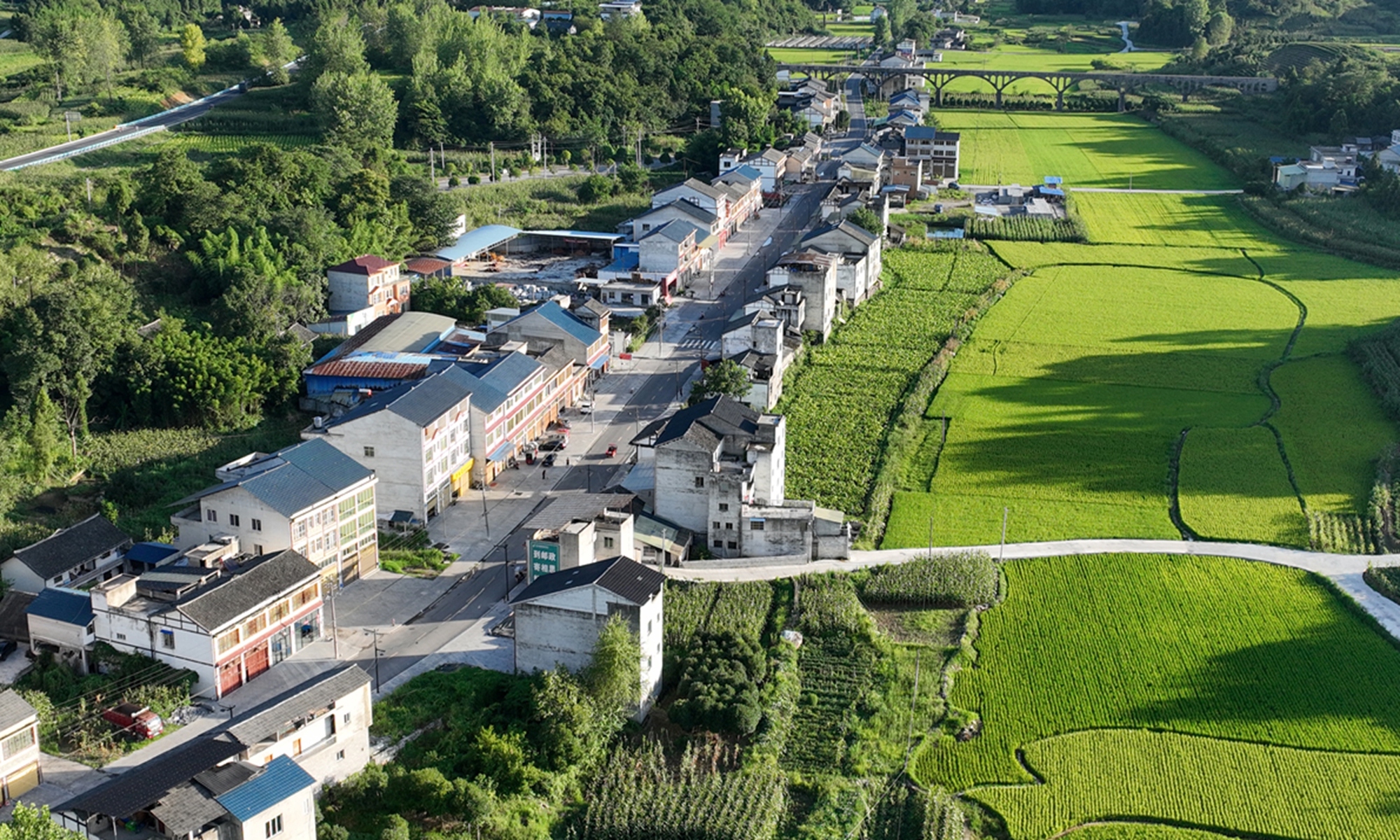Socialist road to rural devt breeds a vast market in hinterland
Rural revitalization, common prosperity to empower economic growth, benefit world

A view of a village after the comprehensive improvement of sanitation in the rural "toilet revolution" carried out in Yachuan town of Zunyi, Southwest China's Guizhou Province, on August 7, 2022. Photo: IC
The Harvard Business Review (HBR) has lately made quite a splash in updating the playbook for winning in the Chinese market, awakening Western multinationals in an opinion piece last week to an often overlooked role of China's huge rural market in underpinning business success.
The Chinese market is apparently beyond its urban centers, concluded the much-viewed op-ed, shining a spotlight on the rural part of Chinese modernization that is behind the rapid rise of the rural consumer market, a complete victory in the fight against poverty, and an indispensable portion of the country's common prosperity vision.
A comprehensive push for rural revitalization, among other key takeaways from the ongoing 20th National Congress of the Communist Party of China (CPC), is considered to lend more strength to the pursuit of rural development as a viable contributor to global growth.
The colossal rural market, the birthplace of many middle-income earners and a great number of people aspiring for a better life, will increasingly be relied on for both domestic and foreign businesses to write success stories in China, they noted.
Rural success stories
The HBR article dated October 12 serves as an imperative wakeup call for Western businesses to align their China market strategies with the country's vibrant rural consumer market.
"It's perhaps worth considering the idea that in many cases the problem is not so much geopolitics as strategy," read the inspirational piece that cited contrasting examples of multinationals that had to pull out from the Chinese market or continue to succeed in the market.
The choice of market-entry strategy decided the fate of US electronics giant Best Buy and semiconductor firm AMD, also US-based.
Best Buy opted to "concentrate on China's wealthier but hotly contested urban centers" while AMD "focused on selling cheaper products to attract price-sensitive consumers in rural markets." Eventually, Best Buy decided to exit the market in 2011, a few years after its foray into China's largest city centers with the opening of huge stores with expansive showrooms. In stark contrast, "AMD's success has forced Intel to respond with a similar strategy, developing low-end processors and phones for the rural market."
The article points to China's huge rural market as an often overlooked part of China success stories at large, experts noted.
"Too many companies bet on urban markets, which caused urban market demands to become saturated, while competition in rural markets is scarce," Li Guoxiang, a research fellow at the Rural Development Institute of Chinese Academy of Social Sciences, told the Global Times on Tuesday.
The rising income of rural residents and the increasing policy support for rural areas would also spark huge economic potential and business space for companies. For example, Li said there is still a huge gap between rural and urban areas in terms of telecom industries and most rural people still use very backward phone products. If enterprises could develop smartphones that are welcomed by rural customers, they will very probably see huge profits.
The country's miraculous victory in the battle against poverty as well as its blueprint for common prosperity is conspicuously pivotal building blocks of rural storytelling.
"The rural population is about 500 million in China, the scale of which is still relatively large. That will prompt a large amount of basic consumption," Chen Ming, a research fellow at the Institute of Political Science under the Chinese Academy of Social Sciences, told the Global Times on Tuesday.
The consumption ability of the rural population has been rising significantly, with an Engel coefficient of rural areas reducing to about 30 percent, which would mean that the rural population will have moved from moderate prosperity toward becoming rich, Chen said.
In a report to the 20th CPC National Congress on Sunday, Xi Jinping said that the CPC embraced its centenary, ushered in a new era of socialism with Chinese characteristics, eradicated absolute poverty and finished building a moderately prosperous society in all respects, thus completing the First Centenary Goal, he said, calling the three major events "historic feats."
He pledged continuous efforts to build a high-standard socialist market economy, modernize the industrial system, advance rural revitalization across the board, promote coordinated regional development, and promote high-standard opening up.
The country will continue to put agricultural and rural development first, pursue integrated development of urban and rural areas, and facilitate the flows of production factors between them. Efforts are also in the pipeline to steadily push the revitalization of businesses, talent, culture, ecosystems, and organizations in the countryside, according to the report.

Farmers promote locally produced watermelons via livestreaming in a county in Southwest China's Guizhou Province. E-commerce in rural areas plays an increasingly important role in enriching local communities. Online sales of agricultural products reached 422.1 billion yuan ($62.49 billion) in 2021, up 2.8 percent year-on-year. Photo: VCG
Chinese path to countryside development
The miracle-making socialist road to rural development with Chinese characteristics comes across as having incubated a vast hinterland market, a lesser-known yet substantial component of the economy's rise as the global growth engine, experts said.
Hong Tao, director of the Institute of Business Economics at the Beijing Technology and Business University, said that with a large amount of investment having been, and continues to be directed to rural revitalization under government strategy, rural markets will become increasingly active. But rural development has its own distinctive features, and investors should prepare for long-term investment in this sector.
"All in all, against the rural revitalization background and integrated development of rural areas' primary, secondary and tertiary industries, rural China's GDP congregate and proportion will gradually increase. In particular, rural areas' secondary and tertiary industries will see improved industrial quality and scale," Hong said.
Besides, rural consumption market's scale and proportion will also gradually increase. It's possible that rural areas will contribute to more than 15 percent of China's total consumption in the short term, he noted.
Tian Yun, a veteran macro economy observer, said that although rural consumption is not the biggest contributor in terms of consumption proportion, its growth has outpaced that of urban consumption.
One reason behind this phenomenon is China's basic policy to shrug off poverty and revitalize the rural economy, which has resulted in large number of public resources being put into rural areas of the country, such as infrastructure.
On the other hand, rural salaries have increased significantly, as many rural people are working in industry or the services sector after agricultural productivity increases continuously, Tian told the Global Times on Tuesday.
Under such a background, experts stressed that rural markets can actually provide an incremental market with huge potential for companies both in China and abroad, and become their new growth point after urban markets are more or less saturated after these years of development.
At the current stage, rural customers might still prefer products that are highly cost effective, which is the key to why companies like Pinduoduo succeeded. But in the future, they will also need more products with high added values with their incomes increasing, Tian noted.
It is expected that rural China's consumption growth will outpace urban consumption by one to two percentage points in the years to come, the economist went on to say.
"I think rural areas will be a powerful momentum for China's future consumption growth, as the rural population base is very high, and their demands for a quality life are far from being satisfied," Tian noted.
According to Tian, such a market will provide opportunities for both domestic and foreign companies. Especially for the latter, they need localization teams that can understand the demands of rural customers.



